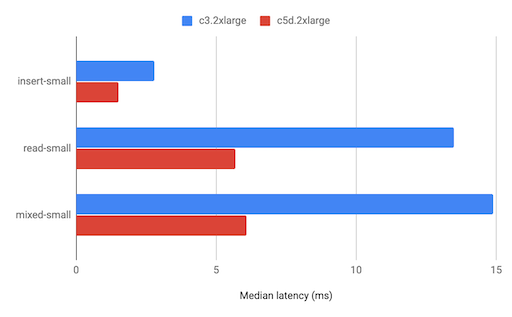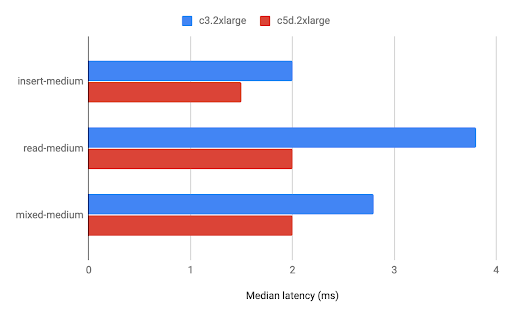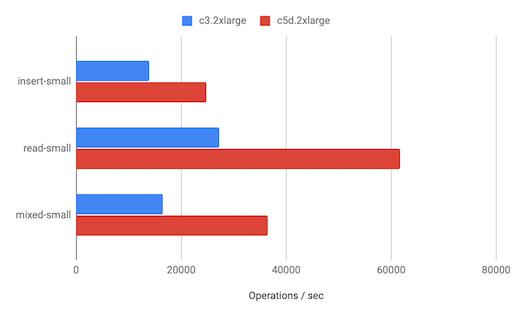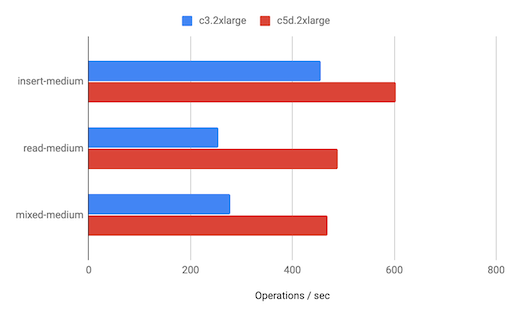Last year, Instaclustr upgraded its support for high throughput, compute intensive nodes on top of the AWS platform. This involved switching away from the aging c3 instance types and onto the newer c5d instance type. The new c5d instances provide better performance, better compute power and is better value for money than the c3 instances.
The new Instaclustr node type is based off the c5d.2xlarge compute image and provisioned with 8 vCPUs, 16GiB RAM and 200GB NVMe SSD storage. These nodes will be suitable for high throughput, low latency deployments of Apache Cassandra.
But how much better are the c5d instances? We ran our standard Cassandra benchmarking tests on c3 and c5d instances running Cassandra clusters to find out. These tests cover a combination of pure read, pure write and mixed read/write operations, with varying data sizes to evaluate Cassandra’s performance on these node sizes.
Below are the results for our basic latency and throughput tests on clusters with 3 nodes, running Cassandra version 3.11.3.
Latency
We measure latency by performing tests with a static number of operations per second across all test clusters. This number of operations is calibrated to represent a moderate load on the least powerful cluster under test. This shows a difference in the amount of time taken to process the same number of requests.
Small Operations
For small sized operations, the c3’s showed 87% higher median latency on insert operations, and 136% higher median latency on read operations.
Medium Operations
Medium sized operations show 33% higher latency on inserts on c3s, stretching out to 90% higher latency for read operations.
Throughput
Then we measure a clusters throughput, by starting at a small number of operations per seconds and increasing them until the cluster starts to become overloaded (indicated by median latency exceeding 20ms for reads, 5ms for writes, or pending compactions being more than 20 on minute after load completes). This tells us if a cluster is able to perform more or fewer requests, in the same amount of time.
Small Operations
For small sized operations, we can see that c5d nodes allow for an 80% improvement in insert operations per second and a huge 125% improvement in write operations per second.
Medium Operations
While for medium data sizes we have the slightly more modest 33% improvement in insert operations per second and the still significant 93% improvement in read operations per second.
Conclusion
Comparing those performance figures against the modest additional price of c5d’s (c5d’s are approximately 15% more expensive, with some variance depending on the region), we can see that c5d’s represent strong value for money improvement over the c3s.
Instaclustr supports the c5d instances in the following AWS regions:
- US-East-1 (N. Virginia)
- US-East-2 (Ohio)
- US-West-1 (Northern California)
- US-West-2 (Oregon)
- Europe-Central-1 (Frankfurt)
- Europe-West-1 (Ireland)
- Europe-West-2 (London)
- Asia-Pacific-Southeast-1 (Singapore)
If you already have a c3 cluster with Instaclustr, don’t worry, these will continue to be supported as normal.
Instaclustr supports a range of machine size configurations across all its cloud providers to make sure there is a size perfect for your needs. To see what we’re offering with the new c5d nodes or any of our other existing nodes sizes, visit our console or contact [email protected].











